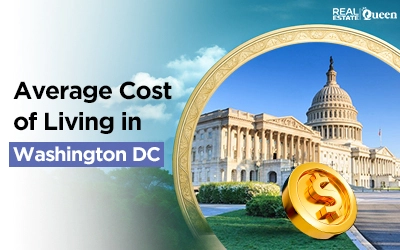
Thinking about moving to Nebraska? The state offers a steady job market and friendly cities. Its cost of living is well below the national average. Because of this, Nebraska is popular with both professionals and families who want great value without losing quality of life.
The average cost of living in Nebraska in 2025 stands at a Cost of Living Index (COLI) of 92.6. That’s about 7.4% lower than the U.S. average. Therefore, your paycheck goes further here than in most other places. Below, see how expenses like housing, utilities, and food stack up statewide.
TL;DR: Average Cost of Living in Nebraska 2025
- Overall COLI: 92.6 (7.4% below the national average)
- Average annual personal expenditure: $52,600 per person
- Required household income: $78,000–$82,000 for a middle-class lifestyle
- Average rent (all units): $1,400/month
- Average utility cost: $172.57/month
- Median home price: $355,766
- Average grocery cost per person: $235/month
- Average salary for comfort: $80,000 for a family of four, $52,000 for a single adult
Understanding Nebraska’s Average Cost of Living
Nebraska offers a rare mix of affordability and opportunities. Most families need about $80,000 each year to live comfortably. Meanwhile, a single adult can get by on about $52,000 per year.
In comparison, families and single adults in Colorado or Minnesota need thousands more. As a result, Nebraska’s lower costs are clear.
Monthly costs in Nebraska usually include:
- Housing: $1,400
- Utilities: $172.57
- Groceries: $235 per person
- Transportation: $50 for public transit, $3.20/gallon for fuel
- Healthcare: $141.50 per month (employer plan)
- Childcare: $850–$1,000 per child
These numbers show why the average cost of living in Nebraska is such a draw for newcomers.
Housing and Rental Market in Nebraska
Housing is a big part of Nebraska’s value. The average rent statewide is $1,400 per month. That’s a 3.7% jump from last year, mostly because of growing demand in Omaha and Lincoln.
Nebraska’s median home price is $355,766. This is moderate when compared to other states in the region.
How does Nebraska compare?
- Kansas: $301,000 (15.4% lower)
- Iowa: $280,000 (21.3% lower)
- South Dakota: $310,000 (12.9% lower)
- Colorado: $550,000 (54.6% higher)
- Minnesota: $370,000 (4% higher)
Omaha tends to have higher rents than the state average. However, smaller cities like Kearney and Grand Island offer lower prices. As a result, there are options for many budgets all over Nebraska.
👉 Searching for homes for sale in Nebraska that match your budget? Find them easily on Houzeo, America’s best home buying website. With advanced filters for price, amenities, bedrooms, and bathrooms, you can explore thousands of listings and secure the ideal property for your needs.
Utilities and Everyday Living Costs Across Nebraska
Living in Nebraska means saving on utilities. The average monthly cost is $172.57, which is 2–4% less than what most Americans pay. Because bills are predictable, budgeting is often easier.
Compared to nearby states:
- Iowa: $181 (5% higher)
- Kansas: $179 (4% higher)
- South Dakota: $187.92 (8.9% higher)
- Colorado: $190 (10.1% higher)
- Minnesota: $199 (15.3% higher)
Food and Groceries in Nebraska
Grocery prices in Nebraska are close to the national average. Expect to spend around $235 each month per person.
- Iowa: 3% cheaper
- Kansas: 4% cheaper
- South Dakota: 1% cheaper
- Colorado: 2% higher
- Minnesota: 2.3% higher
So food costs are familiar, and there are no surprises.
Transportation Costs in Nebraska
Fuel prices average $3.20 a gallon. Meanwhile, public transit costs about $50 per month.
Fuel cost comparison:
- Iowa: $3.10/gallon (about 3% lower)
- Kansas: $3.05/gallon (about 4.6% lower)
- South Dakota: $3.25/gallon (about 1.5% higher)
- Colorado: $3.90/gallon (about 21.8% higher)
- Minnesota: $3.75/gallon (about 17.2% higher)
With lower average costs, it’s easier to get around in Nebraska.
Healthcare Costs in Nebraska
Medical care is not as costly here as in other states. The average employer-sponsored plan costs $141.50 a month, while a Silver-tier plan costs $527. On the other hand, costs are much higher in Colorado and Minnesota.
As a result, Nebraska keeps healthcare both affordable and accessible.
Salaries and Job Market for Nebraska Residents
Nebraska’s job market supports a comfortable life at a lower salary compared to many neighboring states. Most families need about $80,000 to live well.
See how Nebraska compares:
- Kansas: $78,000 (about 2.5% lower)
- Iowa: $75,000 (about 6% lower)
- South Dakota: $74,000 (about 7% lower)
- Colorado: $95,000 (about 18% higher)
- Minnesota: $88,000 (about 10% higher)
Because of Nebraska’s wage strength and cost balance, many earners can save more for their future.
Is the Average Cost of Living in Nebraska Worth It?
So, is Nebraska a smart move? Absolutely. Thanks to lower utility costs, healthcare you can afford, and predictable housing prices, the average cost of living in Nebraska brings stability and security.
Also, Omaha, Lincoln, and Grand Island give residents plenty of lifestyle options. There are strong local communities and good public services throughout the state.
Regional Insights and Relocation Tips
- Omaha: Fast-growing with finance, logistics, and healthcare jobs. Rent is higher, but wages cover the cost.
- Lincoln: Tech and academic jobs with good public amenities.
- Kearney & Grand Island: Smaller cities with cheaper housing and friendly markets.
Therefore, Nebraska combines affordable living with access to resources you’d expect in bigger states.
Final Thought on Nebraska’s Average Cost of Living
In 2025, Nebraska remains a smart, mid-tier choice for cost-conscious buyers. Even though it’s not the absolute cheapest in the Midwest, Nebraska is well balanced. People get affordable housing, steady wages, and reasonable healthcare.
In conclusion, whether you like Omaha’s busy downtown or Lincoln’s college vibe, the average cost of living in Nebraska shows that here, practical value matters just as much as charm.
👉 Start your home search today by exploring the latest Nebraska homes for sale on Houzeo and discover neighborhoods that fit your budget and lifestyle.
FAQs About Nebraska’s Average Cost of Living
Is Nebraska expensive to live in?
Nebraska's cost of living is about 7.4% below the national average, making it relatively affordable compared to many states.
What salary do you need to live comfortably in Nebraska?
Income needed in Nebraska is around $80,000 annually for a family of four and about $52,000 for a single adult.
What is the average rent in Nebraska?
Rent in Nebraska averages about $1,400 per month, though larger cities like Omaha and Lincoln tend to be more expensive.
What makes Nebraska affordable?
Utilities and healthcare in Nebraska are relatively low, and housing is accessible, keeping overall living costs manageable.
How does Nebraska compare to nearby states?
Nebraska's affordability is higher than in Colorado and Minnesota, but slightly lower than in Kansas and Iowa.






